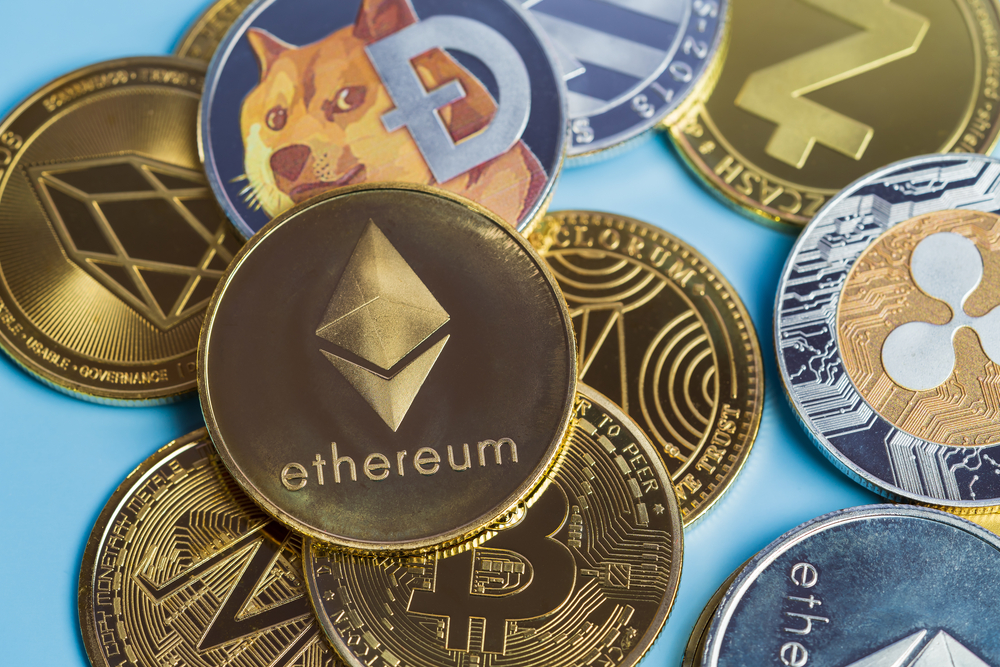Despite being on opposing sides on the scale, Ripple and Ethereum are both among the most renowned cryptocurrencies worldwide and have always consistently generated comparisons. On December 29th, 2017, Ripple surpassed Ethereum to become the world’s second-largest cryptocurrency. Even though it was for a brief period but surpassing Ethereum is an achievement in itself.
Moreover, Ripple has had a few run-ins with regulatory agencies, including the SEC (Securities and Exchange Commission). Ethereum and Ripple are in conflict-gathering forms as both blockchains continue to generate revolutionary solutions with significant repercussions across several industries.
So, what distinguishes these two well-known blockchain initiatives, even though they are all Blockchain based? What are the parallels between them? This guide will provide answers to all these and other questions. Before going deeper, let’s take a quick look at these two cryptocurrencies.
Understanding Ripple
Ripple is the organization underlying the cryptocurrency XRP, which collaborates with established financial firms to allow international transactions and payments through its network.
The crypto token Ripple (XRP) is intended to move transactions away from central databases owned by financial firms and toward a more transparent network while drastically reducing costs. XRP payments are trustless, quick, and inexpensive, making them ideal for international transactions.
Ripple, introduced in 2012, has significant ambitions in the cryptocurrency world. The XRP Ledger, which is software that allows the usage of XRP, introduced a new manner of managing blockchains that enthusiasts argue is better appropriate for transactions.
As a prominent XRP token holder, Ripple contributes to the upkeep of the XRP Ledger Software and has an essential role in its growth.
In the case of Bitcoin, anyone may get processing power, verify transactions, and protect the Blockchain. The XRP Ledger, on the contrary, only permits selected network members to assist in transaction validation and network security. About 150 network members make up this group and are called the “Unique Node list”.
About its history, Ryan Fugger, a computer programmer, created RipplePay in the year 2004-2005 to offer a safe payment alternative for people on the social web. RipplePay is the foundation for Ripple, which Jed McCaleb established. He believes that Bitcoin is incredibly resource-intensive, which weakens the entire system.
Hence, he created Ripple pay as Bitcoin’s alternative. Consequently, McCaleb approached Fugger with a plan to use RipplePay as a crypto network. Fugger gave over management of RipplePay, opening the door for establishing Ripple and XRP.
XPR keeps all transaction information on the XRP ledger and relies on trustworthy validator nodes to establish consensus, which requires about 3-5 seconds.
Furthermore, XRP uses a consensus method combining numerous bank-owned systems to validate transactions. Validators confirm the validity of requested transactions by matching them against the latest XPR Ledger versions.
Anyone who wants to get their hand on the XPR can create a wallet with at least 20 tokens. Several crypto wallets compatible with the Ripple network are available in the market. But various users also opt to store their XPR tokens on crypto exchanges.
That, too, comes with some drawbacks, such as getting hacked. As an alternative, some users opt for the software XPR wallet. These wallets bestow users’ private keys for the security of their assets.
Before transferring your assets to a wallet, obtain one by purchasing XRP. You can find XPR on the majority of the leading cryptocurrency exchanges. Users who purchase XRP via exchanges can store their coins on the exchanges or transfer them into their wallets. Trading XRP is similarly simple on exchanges, particularly ones with a high market ca
Benefits of Ripple
Fast Transaction Speed
In comparison to several other cryptocurrencies, Ripple can execute a large number of transactions in a second. Ripple can process around 1500 transactions in one second, compared to Bitcoin, with a processing speed of 3 to 6 transactions in one second.
Less Problematic
Many individuals are concerned regarding the fate of cryptocurrencies owing to regulatory issues. Ripple is unlikely to be harmed because it collaborates with several of the world’s major financial firms.
Ripple programmers have effectively produced a solution demanded by several big financial organizations by concentrating their work on financial institutes.
No Competition
Ripple does not compete with other cryptocurrencies, such as Bitcoin. Instead, it supplements them by urging the financial industry to embrace blockchain solutions.
Drawbacks of Ripple
Centralization
One of the aims of Blockchain is to provide decentralization, which means no third-party involvement. Ripple disagrees with this because the corporation controls 60% of its total XRP.
Limited Use
Ripple has limited everyday use because it is exclusively intended for use by major financial companies. Many prospective investors view this as a disadvantage that might hinder future growth.
Distribution
Another common feature that cryptocurrencies share is distribution. Because XRP does not require mining, corporate organizations such as banks serve as validators. In this respect, it differs from other cryptocurrencies.
Confidentiality and Privacy
The concept of anonymity and privacy is less strong with Ripple than with other cryptocurrencies, which is a significant drawback of this platform.
Understanding Ethereum
Ethereum is a computing platform that works on a blockchain system that allows developers to create and operate decentralized apps. A single authority does not control a decentralized system. Ethereum, like other cryptocurrencies, has a blockchain framework similar to Bitcoin but includes different functions like smart contracts.
Ethereum allows you to build code that governs digital currency, works precisely how you design it, and is available internationally. In 2015 Vitalik Buterin started Ethereum. Since then, it has developed itself as the second-biggest blockchain network.
Ethereum enables people to execute transactions, be involved in staking and earn a profit, acquire, store, and utilize NFTs, trade cryptocurrencies, play online games, and much more. Ethereum wasn’t designed to be a store of value or a means of trade.
Rather, it was designed universal computing platform which is also decentralized and capable of applying the safety and transparency of blockchains to a wide range of applications.
The native coin of the Ethereum network, ETH, works as the network’s energy, driving development and activity. The system employs the PoW (Proof Of Work) algorithm just like Bitcoin, forcing miners to tackle challenging arithmetic problems to verify transactions and ensure the network’s security in exchange for freshly minted ETH.
However, it will soon shift to PoS (Proof of Stake), hopefully by the end of the protocol’s scheduled updates. Ether is the cryptocurrency used by the Ethereum blockchain. Unlike Bitcoin, whose cap supply is kept at 21 million, no maximum quantity of Ether is issued.
However, as per Vitalik Buterin, the creator, this quantity will eventually be restricted to around 100 million tokens. The supply of ETH was a little over 100 million in 2018, indicating that no additional tokens will be produced anytime soon.
Benefits of Ethereum
Some of the advantages of Ethereum are as follows:
Decentralization
Ethereum’s decentralized architecture efficiently shares information and confidence among participants in the system, eliminating the requirement for a centralized organization to manage the platform and arbitrate transactions.
Rapid Implementation
Instead of starting from the bottom, enterprises can easily develop and manage private blockchain platforms with the employment of platforms like using Hyperledger Besu.
Permissioned Platform
Several accessible protocol levels enable businesses to operate on both private and public Ethereum networks while ensuring that their offering fulfills all legislative and safety criteria.
Network Size
The Ethereum mainnet proves the viability of a system with nodes numbered in hundreds and millions of members. Most commercial blockchain rivals exploit the benefits with fewer than ten nodes and lack experience with big and profitable networks. Network size is critical for business partnerships that are sure to surpass only a few nodes.
Interoperability
Whenever you create an application on Ethereum, you can quickly link it to several existing protocols. This is referred to as money legos. Recently, popular financial items have been created and released on the Ethereum network in a short amount of time. This is only conceivable since these systems do not start from the bottom and may link to existing facilities.
Volatility and Liquidity
Ethereum ranks as the second largest cryptocurrency worldwide, allowing you to invest in Ether and not worry about a huge slippage incident or not being able to locate a buyer. You may even swap it for size while remaining fearless. And the incredible liquidity accompanies a reasonable estimate of volatility.
A volatile investment is one with huge price swings, frequently fluctuating. Ethereum has had a good share of volatility throughout the years. A few speculators prefer Ethereum to Bitcoin since it provides better profits. Above all else, liquidity is a good indicator. Liquidity suggests that there is genuine demand for a coin.
Liquidity suggests that a cryptocurrency has a genuine market, and speculators are willing to keep purchasing and trading it. There is no long-term worth in an investment product.
Drawbacks of Ethereum
Scalability
Ever since the inception of blockchain technology, Ethereum’s developers have worked on scalability issues. Although it will not be deployed in the system anytime soon, sharding’s implementation in the future might assist with the majority of Ethereum’s difficulties.
Increasing Transaction Costs
Gas fees are payments for conducting a transaction in the Ethereum network. These expenses grow when clients seek to speed up transactions to gain a competitive advantage. Consequently, transaction fees are quite high.
Lagging Behind Bitcoin
Although having the benefit of being the first cryptocurrency to come close to Bitcoin, Ethereum will always finish second. In light of the massive price discrepancy between the two coins, many believe they cannot be in the same category.
Key Differences Between Ripple and Ethereum
Primary Objective
Ethereum was designed to compete with financial firms by creating a decentralized infrastructure where people could transact and trade without interference from a central authority. That means there will be no third person involved in the system.
Consequently, the platform serves as a place where individuals can come together to establish initiatives and decide how the number of modifications might be executed.
Ethereum also brings peers to collaborate on initiatives they believe in. Furthermore, it can also be used to facilitate the creation and production of new tokens known as ERC20.
On the contrary, Ripple was founded to assist financial firms instead of competing with them. The main objective of its Blockchain is to make it simple for financial firms to conduct cross-border transactions. The initiative is centralized rather than decentralized. Thus, any modifications must be approved by consensus.
RippleNet is a blockchain technology backed by Ripple that is gaining popularity for enabling cross-border transactions. The platform also supports immediate transaction processing and bidirectional communications. Ripple promotes itself as a beneficial cross-border payment system, whereas Ethereum views itself as a virtual currency and a medium of exchange.
Functions
Ethereum and Ripple serve quite distinct functions in the greater cryptosystem. Aside from serving as a store of value, Ethereum is used in various DeFi apps, Smart contracts, and various other things.
Ethereum was designed to function as a decentralized, universal software system capable of exploiting blockchains. Conversely, Ripple’s use is significantly more direct. It facilitates cross-border transactions and exchanges and serves as a medium for currency exchange.
Coin Supply
Talking about the token supply of Ethereum and Ripple differ substantially. Ethereum’s token, i.e. ETH, has an unlimited supply. It rather prefers to alter the release of additional ETH tokens by consensus.
At Ethereum’s Genesis block total of 72 million ETH was released, with 60 million going to donors to the 2014 Ethereum ICO and the remainder 12 million going to the fund. All ETH earned beyond the initial 72 million were generated via block incentives. Currently, 119 ETH exists in the system.
A total of 100 billion XPR tokens were created at the inception of Ripple and will be progressively distributed in the industry. Forty-five billion XPRs are currently in circulation.
Approximately 6 million XPR are owned by Ripple. The remaining is kept in escrow. Escrows are ledger mechanics on the XPR ledger system governing token distribution.
Consensus Mechanism
Before we go into the consensus method, let’s define the concept of “Consensus.” Before the transaction is verified on the Blockchain, a specific percentage of nodes must acknowledge that the transaction is genuine. This whole process is called consensus.
Ripple employs a process called Federated Byzantine Agreement (FBA). It differs from Proof-of-Work, which Ethereum employs as a consensus protocol. Ripple employs “transaction validators,”. The persons who can become one are banks that adopt the Ripple system.
The Ripple Consensus Mechanism is exceptionally quick, with a transaction rate of 1,500/ sec. At the same time, Ethereum operates on the PoW process, similar to a riddle. One of the biggest problems with Ethereum’s consensus process is that it cannot scale a huge volume of transactions, with a total of 15 transactions/sec.
To address the current challenge, Ethereum engineers are attempting to transition to a more energy-efficient mechanism Proof-of-Stake (POS) method utilizing the Casper Protocol.
Performance
Ethereum’s scalability issues and high transaction costs are well-recognized in the crypto community. At the moment, Ethereum can execute about 30 transactions/sec, causing substantial traffic on the Ethereum blockchain. This has the unintended consequence of raising gas costs as consumers fight to complete their purchases.
Consequently, a slew of layer-1 and layer-2 Ethereum solutions have emerged. Ripple transactions, on the contrary, are immediate, with the network processing transactions in about 5 seconds. Ripple requires rapid transactions for the system to work as a transaction settlement mechanism.
Transaction Costs
The gas costs on Ethereum vary according to the traffic on the network at that moment. Consequently, Ethereum has struggled with excessive transaction fees. Ripple has a set transaction cost of 0.00001 which is much less than Ethereum. Ripple’s costs are intentionally maintained insignificant, so banks may perform big transactions regularly.
Technology and Future Growth
Ripple is a distributed protocol that allows for quick payments with low costs. The network’s process permits cross-currency transactions without requiring a centralized authority. On the contrary, Ethereum software enables the Blockchain to verify and execute code.
Ethereum also supports decentralized apps comparable to conventional computer programs but have a higher level of safety and are less likely to fail.
Conclusion
Ethereum and Ripple are prominent cryptocurrencies at opposing extremes of the crypto scale, serving very distinct functions. Because of the development of Decentralized finance, Non-fungible tokens, and decentralized apps, Ethereum has witnessed a boom in popularity, resulting in higher engagement of people on the Ethereum platform.
Though Ethereum’s present image is dealing with several difficulties that might impede its general acceptance, it is vital to note that the Ethereum network has been trying to process its most critical update since its conception.
Ripple plays an opposite role compared to Ethereum. Ripple wants to collaborate with the current financial institution to enable cross-border transactions as effectively as possible. The platform has launched multiple collaborations with prominent financial firms and hopes to gather major financial firms on board. Ripple is a powerful project that has the potential to be an essential part of the pervasive environment.







More Stories
Post Ethereum Merge: Grayscale Seeks More Time To Review ETHPoW Stance
SEC Chair Suggests Regulating Proof-Of-Stake Ethereum Projects As Securities
Bitcoin Holds Strong As Banking Crisis Continues